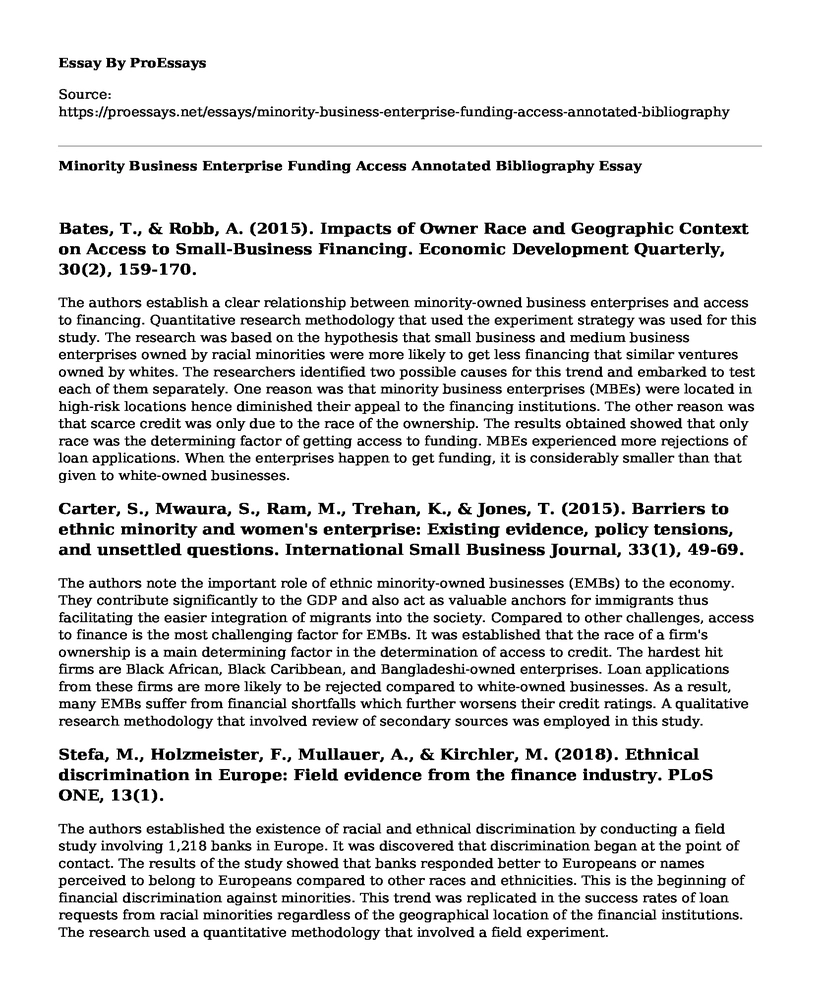Bates, T., & Robb, A. (2015). Impacts of Owner Race and Geographic Context on Access to Small-Business Financing. Economic Development Quarterly, 30(2), 159-170.
The authors establish a clear relationship between minority-owned business enterprises and access to financing. Quantitative research methodology that used the experiment strategy was used for this study. The research was based on the hypothesis that small business and medium business enterprises owned by racial minorities were more likely to get less financing that similar ventures owned by whites. The researchers identified two possible causes for this trend and embarked to test each of them separately. One reason was that minority business enterprises (MBEs) were located in high-risk locations hence diminished their appeal to the financing institutions. The other reason was that scarce credit was only due to the race of the ownership. The results obtained showed that only race was the determining factor of getting access to funding. MBEs experienced more rejections of loan applications. When the enterprises happen to get funding, it is considerably smaller than that given to white-owned businesses.
Carter, S., Mwaura, S., Ram, M., Trehan, K., & Jones, T. (2015). Barriers to ethnic minority and women's enterprise: Existing evidence, policy tensions, and unsettled questions. International Small Business Journal, 33(1), 49-69.
The authors note the important role of ethnic minority-owned businesses (EMBs) to the economy. They contribute significantly to the GDP and also act as valuable anchors for immigrants thus facilitating the easier integration of migrants into the society. Compared to other challenges, access to finance is the most challenging factor for EMBs. It was established that the race of a firm's ownership is a main determining factor in the determination of access to credit. The hardest hit firms are Black African, Black Caribbean, and Bangladeshi-owned enterprises. Loan applications from these firms are more likely to be rejected compared to white-owned businesses. As a result, many EMBs suffer from financial shortfalls which further worsens their credit ratings. A qualitative research methodology that involved review of secondary sources was employed in this study.
Stefa, M., Holzmeister, F., Mullauer, A., & Kirchler, M. (2018). Ethnical discrimination in Europe: Field evidence from the finance industry. PLoS ONE, 13(1).
The authors established the existence of racial and ethnical discrimination by conducting a field study involving 1,218 banks in Europe. It was discovered that discrimination began at the point of contact. The results of the study showed that banks responded better to Europeans or names perceived to belong to Europeans compared to other races and ethnicities. This is the beginning of financial discrimination against minorities. This trend was replicated in the success rates of loan requests from racial minorities regardless of the geographical location of the financial institutions. The research used a quantitative methodology that involved a field experiment.
Cite this page
Minority Business Enterprise Funding Access Annotated Bibliography. (2022, Apr 04). Retrieved from https://proessays.net/essays/minority-business-enterprise-funding-access-annotated-bibliography
If you are the original author of this essay and no longer wish to have it published on the ProEssays website, please click below to request its removal:
- Essay Sample on Derivatives Options and Swaps
- Ethics in Investment Management Essay
- Case Study on Financial Literacy
- Is HIPAA Sufficient? Essay Example
- Essay Example on Estate Planning: Bequeathing Assets & Settling Taxes
- Essay on Governor Introduces Budget Cuts: Evaluating Areas for Financial Cut Down
- HPMG Joins Local Hospitals: Fixed Pay & EHR Goals - Free Report Sample







